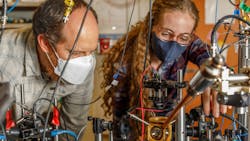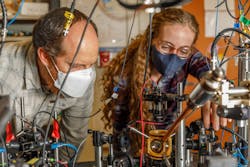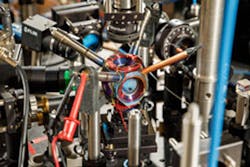Millions of devices use GPS for navigation. Its constellation of two dozen orbiting satellites lets users’ devices know where they are (and the time) anywhere on Earth. But GPS can be jammed or spoofed, potentially rendering navigation devices on commercial and military equipment useless.
To get around that shortcoming (and several others), researchers at Sandia National Lab have been developing an avocado-sized quantum device that acts as a self-contained inertial navigation system; it does not need an array of orbiting satellites to work. Instead, several lasers are fired into a swirling cloud of rubidium atoms. It then employs quantum sensors to determine the acceleration and rotation the device has undergone based on the lasers signals after they bounce of the moving rubidium atoms.
There already are atomic accelerometers and gyroscopes that can be fashioned into accurate inertial navigation systems, but they’re too big and the vacuum they require would consume thousands of volts of electricity.
To make the quantum inertial nav system practical, the research team needed to be compact and rugged. Fortunately, the team discovered that quantum sensors do not need a high-powered vacuum system to work. This let the researchers shrinks the device to a practical size without sacrificing reliability.
Without the vacuum, though, a new way to remove molecules that leak in and wreck measurements needed to be found. The team went with a pair of “getters” which use chemical reactions to bind intruding molecules and consume no power. The getters are each about the size of a pencil eraser and are inserted inside two narrow tubes sticking out of the device’s titanium shell.
To keep out offending molecules, Sandia material scientists built the device and containment chamber out of titanium and sapphire. These materials are adept at keeping out gasses such as helium, which can make its way through stainless steel and Pyrex glass. The team used fabrication methods developed for the U.S. nuclear weapons program to bond the advanced materials.
Construction took sophisticated fabrication techniques that Sandia has honed to bond advanced materials for nuclear weapons components. And like a nuclear weapon, the titanium chamber must work reliably for years.
For over a year, the avocado-sized device has contained its cloud of atoms at the right conditions for precise navigational measurements. It is the first device small, energy-efficient and reliable enough to make quantum sensors viable for commercial use.
The Sandia team continues monitoring the device with the goal of keeping it sealed and operating for five years, an important milestone for showing the technology is ready for the marketplace. In the meantime, the researchers are exploring ways to streamline and simplify manufacturing the device.


